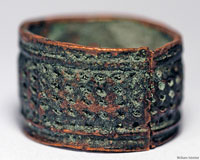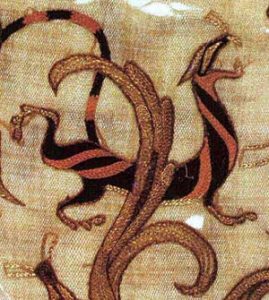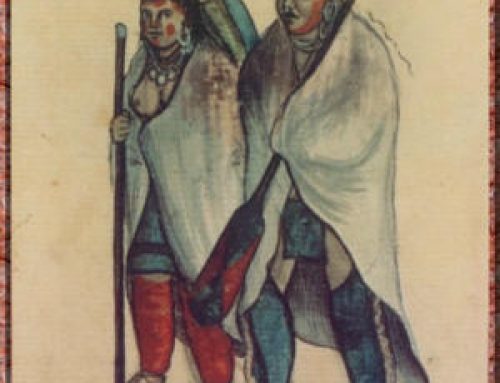
Early thimble-ring from Han Dynasty China (200 BC-200 AD)
During the Han Dynasty, about 200 BC, Chinese blacksmiths started to make sharp, thin steel needles (this is about 100 years after Indian metal-workers began to make steel). Chinese tailors and seamstresses needed these thin, strong needles to sew silk clothing, which was more and more important as China began to export a lot of silk along the Silk Road. Doctors soon started to use these needles for acupuncture.

Han Dynasty embroidery (200 BC-200 AD)
Soon afterwards, Chinese tailors and seamstresses began to use bronze thimble rings to protect their fingers from these thin needles as they sewed fine clothing with lots of fancy embroidery on it. These thimble rings quickly spread, with the needles and the silk, to Tashkurgan (now in western China) and to the Scythian Chersonese (on the Black Sea). The needles spread too; there were needle factories in Antioch and Damascus and Adrianople in the 200s AD, making possible the Egyptian Coptic embroidery that begins no later than 500 AD.

Coptic embroidery from Egypt (silk on linen,500-700 AD, now in Metropolitan Museum of Art)
People in China kept on using thimble rings, but in Central Asia and West Asia thimbles became dome-shaped like modern thimbles by about 1000 AD – maybe because people in Central Asia and West Asia were sewing cotton instead of silk. Thick, heavy thimbles used to sew leather or sailcloth soon reached Islamic Spain about the same time, but fine steel needles and thimbles took longer. By the 1200s AD, people in France were using both steel needles and the thimbles that went with them.
In the late Middle Ages, with the invention of the spinning wheel in the Islamic Empire or China in the 1200s AD, people could make cloth faster, and so cloth was cheaper. More people could afford to wear clothes sewn to fit their bodies, so sewing also became more important. To meet the demand for more sewing, people began to work on making better sewing needles. Soon Spanish metal-workers were making steel sewing needles. By the late 1300s brass-workers in Nuremburg, Germany saw an opportunity to sell their work on the Silk Road and began exporting brass thimbles by the donkey-load to Venice, and from Venice to the Mamluks in West Asia. By the end of the Middle Ages, West Asia was importing thimbles just as it had begun to import sugar, cotton, and paper.
There’s really not much time between the invention of steel sewing needles in the 1300s and the invention of sewing machines. By the 1600s, English wire-makers had invented a machine to mass-produce sewing needles, instead of having to make each needle by hand. In the 1700s, with the success of the spinning jenny, people were working hard to invent sewing machines. By the 1800s, sewing machines were already common all over the world, in ordinary households as well as in factories. But not long after that, sewing became more of a hobby than a necessity, as stores began to sell clothes readymade – sewn by other people – instead of selling cloth for women to make up into clothes at home.
Learn by Doing – sew a stuffed animal
Early history of sewing
More about weaving
Bibliography and further reading about sewing machines:
You Can Weave!: Projects for Young Weavers, by Kathleen Monaghan (2001).
World Textiles: A Concise History, by Mary Schoeser (2003). For adults.
Women’s Work: The First 20,000 Years : Women, Cloth, and Society in Early Times, by Elizabeth Wayland Barber (1995). Not for kids, but an interested high schooler could read it. Fascinating ideas about the way people made cloth in ancient times, and why it was that way.





[…] the same time, the first sharp steel needles reached India from China, and as a result rich men and women began to wear stitched clothing fitted […]